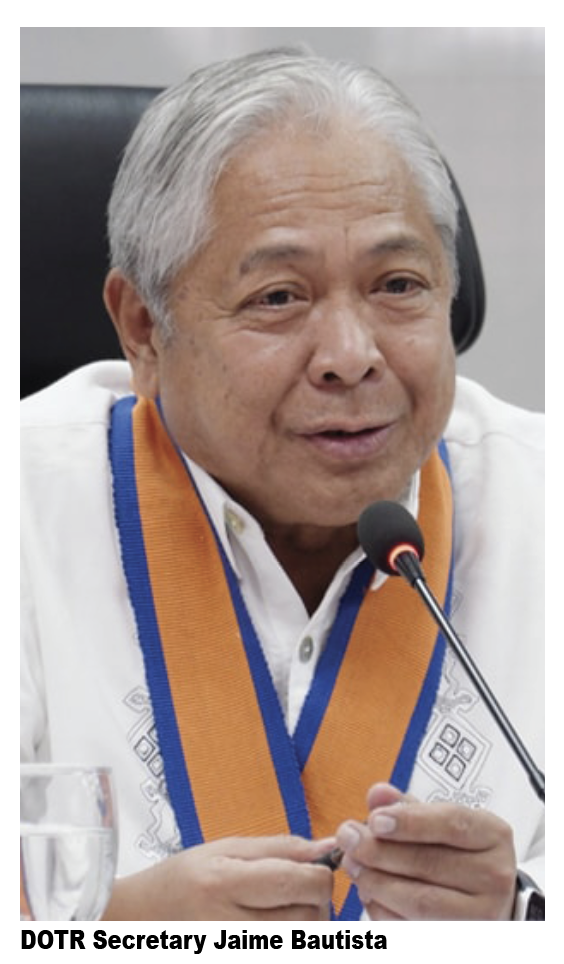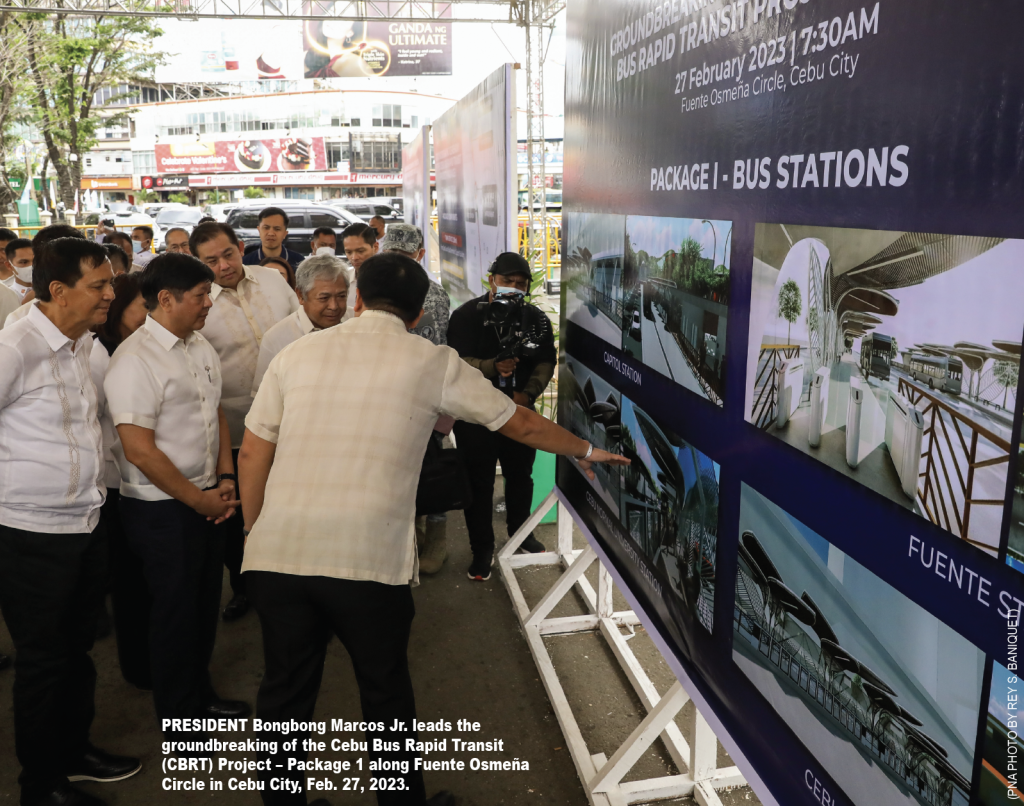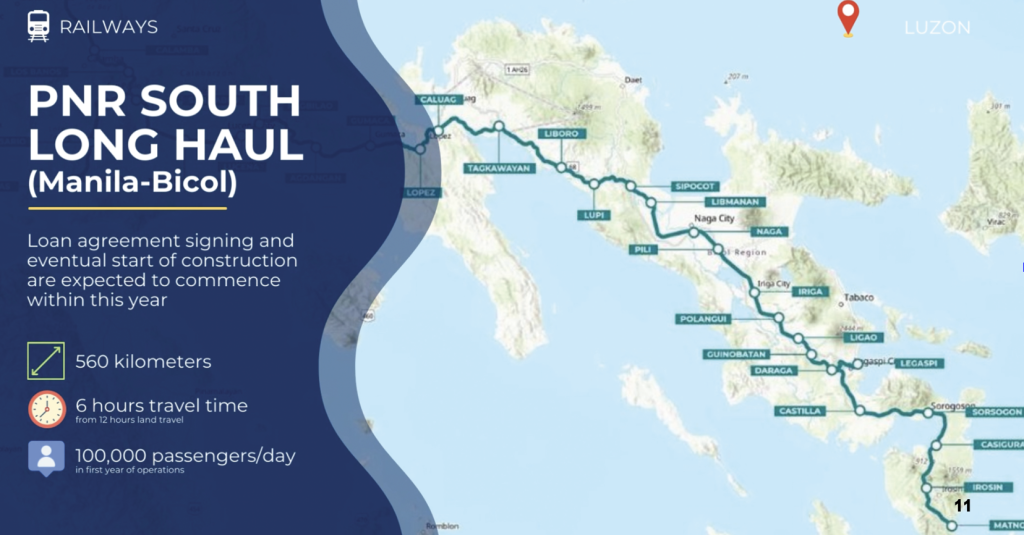Traffic costs the economy P3.5 billion a day for Metro Manila and P2.4 billion for surrounding provinces such as Bulacan, Rizal, Laguna, and Cavite.

By TONY LOPEZ
The Marcos Jr. administration is undertaking the most massive transport modernization ever in the republic’s 125 years of history.
The National Economic Development Authority (NEDA) has approved a total of 194 infrastructure flagship projects or IFPs with total costs exceeding P8.5 trillion.
Of the 194 IFPs, 71 projects or 36.6% are being undertaken by DOTr and costing P4.775 trillion, 56% of total infra cost.
In all, DOTR is undertaking 160 projects, including 71 flagship transport projects.
The 160 projects
The DOTR 160 include 28 projects are aviation, 26 maritime, 59 railways, and 47 under the road sector under 20 themes.
The themes or advocacies include: reducing logistics costs, creating transport jobs, transport safety and security, carbon neutrality, disaster resilience, gender equality, disability, and social inclusion, among others.
Also, advocacies are digitalization, electric vehicles, institutional strengthening, and rightsizing.
The Budget Department has identified six priority expenditures under the 2024 national budget. These are:
• Shovel-ready infrastructure projects
• Investments in human capital development
• Sustainable agriculture and food security
• Climate change adaptation and mitigation
• Digital transformation
• Regional development
“The status quo in the country’s transport sector is unacceptable,” winces Transportation Secretary Jaime Bautista.
Thus, he says, “We are rushing projects to reduce traffic, waiting lines, smoke-belching jeepneys, flight cancellations, and many other passenger inconveniences.
A 2019 study by the Japan International Cooperation Agency or JICA said traffic costs the economy P3.5 billion a day for Metro Manila and P2.4 billion for surrounding provinces such as Bulacan, Rizal, Laguna, and Cavite.
Annually, the direct economic cost of traffic congestion is more than P1.277 trillion, hence “We need to accelerate the completion of our projects.”
The big-ticket projects are primarily designed to improve the mobility and connectivity of people and goods. Allow me to update you on these game-changing projects.
Aviation
DOTr is expanding existing airports and building new ones to address future demand. Aerodrome design will be elevated to international and local safety standards. Level of service standards will be adopted in all airports to quantitatively measure comfort.

4 bidders for NAIA
First off, DOTR is privatizing the Ninoy Aquino International Airport, or NAIA. There are four bidders, each committing P60 billion in 15 years.
DOTR is also expanding the Bukidnon Airport by 2026.
The airport will cater to turboprop aircraft operations serving Bukidnon and nearby provinces, boosting the economic and trade growth of North-Central Mindanao.
Also, Catbalogan Airport will handle turboprop operations covering Eastern Visayas. Catbalogan Airport should be operational by 2025. The airport will serve as a reliable, sustainable, and resilient transborder infrastructure supporting tourism and trade growth in the area.
Dumaguete airport will be transferred to the town of Bacong which is 8.5 kilometers south or 10 minutes away from Dumaguete City. The new airport will be three times bigger than the existing one. We are now in the process of procuring the land. Transferring the airport will cost P17 billion, using the Official Development Assistance fund from the government of South Korea.
To be expanded is the Passenger Terminal Building of Tacloban Airport, while Kalibo Airport’s expansion involves both the terminal and runway.
Other plans:
— Privatize 10 other provincial airports, including the Bicol International Airport and Laguindingan Airport.
— Beginning 2024, increase the capacity of the Laguindingan from 1.6 million passengers a year to initially three million, then to almost six million passengers annually. Cost: P12 billion.
— Siargao, Zamboanga and Masbate airports.
Of course, the P750 billion New Manila International Airport is slowly rising in Bulacan.
Land development is more than three-fourths complete. “We expect structures to rise starting the second quarter of 2024,” says Bautista.
San Miguel Corporation, which is building the airport, said that no dredging is involved in the land development, merely reclaiming what was once land masses in that area as shown by existing land titles.
Bulacan Airport decongest NAIA and complement the operations of Clark International Airport.
Clark Airport
Clark, together with Mactan-Cebu International Airport are two international gateways that are successful models of turning over airport operations and maintenance to the private sector.
Clark is currently operated by a private consortium, the Luzon International Premier Airport Development Corporation or LIPAD.
Mactan-Cebu is managed by the GMR-Megawide consortium.
There are 90 airports in the country. Only half or 45 have commercial operations. Nine are international gateways while 25 are night-rated.
Roads
Bautista says “Our land transport initiatives are shifting focus on public transport, to maximize the use of limited highways. We want private vehicle owners to abandon their cars in favor of trains, buses, taxis, bicycles, motorcycle taxis, and other public transport.”
A success is the Parañaque Integrated Terminal Exchange or PITX formerly known as the Southwest Integrated Terminal System.
DOTR IS replicating PITX in Taguig — the Taguig City Integrated Terminal Exchange or TCITX. The project is currently in the stage of developing its Detailed Engineering and Architectural design.
The TCITX, spanning an area of 34,584 square meters, is estimated to cater to an average foot traffic of 160,865 passengers daily. It can also accommodate 5,400 buses in total.
Road sector
By Secretary Jaime Bautista
(Excerpts from RCM speech, Aug. 17, 2023)
Our Road sector continues to promote active transport or the use of bikes by expanding or creating new bike lanes and pedestrian walkways to further increase accessibility of key activity areas and fundamental facilities in urban centers.
This year, 400 kilometers of active transport infrastructure in nine regions shall be completed, along with the maintenance and upgrading of existing infrastructure to sustain their functionality and safety.
Helping us complete the civil works for these bicycle lanes and pedestrian walkways are the Metropolitan Manila Development Authority or MMDA, the Department of Public Works and Highways, and various local government units. We need to get their approval and buy-in to achieve the timely implementation of the project.
Last August 4, we broke ground for establishing bike lane infrastructure in Kalibo, and recently, at Laoag City.
PUV modernization
On the much-talked-about public utility vehicle modernization program or PUVMP, more than 1,700 transport cooperatives have been accredited, comprising more than 262,000 members more than 100,000 jeepneys, and 14,000 UV Express units.
These accredited cooperatives operate a total of 7,313 modern jeeps nationwide, of which 381 are e-jeeps. Cooperatives can choose from more than a hundred different models of modern jeepneys offered by 49 manufacturers. Eight models are electric.
Transport coops

About 66.16% of these transport cooperatives have submitted their transport route plans to their local government units, with 148 route plans already approved.
The social component of the PUVMP has more than 23,000 drivers and their family members benefitting from the Tsuper Iskolar Program, while more than 5,000 beneficiaries were provided livelihood grants under the EnTsuperneur Program.
In 2023. more than 9,000 were provided scholarships under the Tsuper Iskolar Program while 14,250 additional beneficiaries will be provided livelihood assistance packages under the EnTSUPERneur Program.
EDSA greenways
Another road project is the EDSA Greenways Project which provides commuters with an environment-friendly, five-kilometer elevated walkway along EDSA.
The covered green walkways connect MRT 3 stations to other modes of transport.
The project also involves improving pedestrian facilities and ensuring accessibility to persons with disabilities, the elderly, and the very young.
Phase 1 covers four areas — Balintawak and Cubao in Quezon City, Guadalupe in Makati, and Taft Station in Pasay.
Busways in Cebu and Davao
DOTR is replicating the EDSA busway in Cebu and Davao: Bus Rapid Transit or BRT.
The ground was broken for the Cebu BRT last February led by President Ferdinand Marcos Jr. This BRT is a 13.18-kilometer segregated bus lane, with 17 stations, one terminal, and one depot.
BRT will improve passenger mobility by providing an eco-friendly mode of transport that is fast, comfortable, cost-effective, efficient, and generates fewer emissions.
The project is scheduled for partial operations by the fourth quarter of 2023. Full operation is seen by the first quarter of 2027.
A few weeks back, the President was with some members of the Cabinet in Davao to witness the signing of a one-billion-dollar loan for the Davao Public Transport Modernization Program.
The project is funded by ADB, the National Government, and the Davao City government.
This P73.9 billion project involves the construction of the Davao Bus Rapid Transit which extends to more than 500 kilometers of road system for use by more than a thousand public buses, of which more than 300 will be electric. The project is expected to start operations by 2025.
Another important road project is the construction of the El Nido transport terminal in Palawan.
Funds for the project are being transferred to the local government of El Nido who is expected to start construction this month.
The terminal should be completed by the third quarter of next year.

